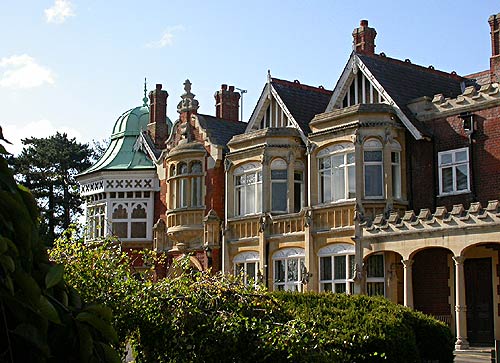
|
|
THE BLETCHLEY PARK estate is situated in the
small town of Bletchley which now forms part of
the sprawling 'new town' of Milton Keynes. Before
World War 2 Bletchley was a just a village
nestling in the gentle hills of the
Buckinghamshire countryside. Its main claim to
fame at that time was as a railway junction on
the main LMS line from London (Euston) to the
North West and for the branch lines that ran
westwards to Oxford and eastwards to
Cambridge.
The estate mansion house, situated
just to the west of the railway, had been built
by a ‘Mr Coleman’ in the late 1870s
and later enlarged by its next owner, a Samuel
Seckham, who had purchased the property in 1881.
|
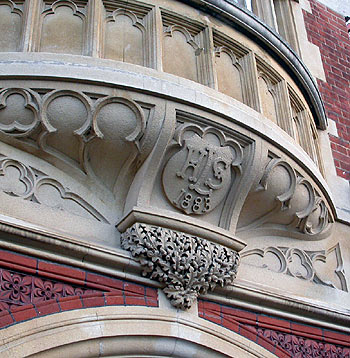
Herbert (Sammy) Leon, a London
stockbroker and friend of David Lloyd George,
bought the estate just a year or two later. The
main building on the estate is the mansion, a
mixture of mock-Tudor and Gothic styles and
constructed mainly of red brick.
At the time of the Leons' residency
the extensive grounds also contained the Home
Farm (which became well kown for its cattle
breeding), various outbuildings, stables,
cottages, a small lake, croquet lawn, a maze (now
the site of the tennis courts) and rose gardens.
Herbert Leon was made a baronet in 1911. He died
in 1926.
The balcony over the main
door, showing the crest of Sir Herbert Leon.
(Right)
The octagonal building with
the conical roof was the mansion's ice-house used
as a produce and meat cold-store. (Below)
|
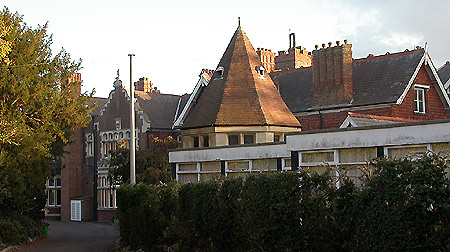
Sir Herbert’s widow, Lady
Fanny Leon, continued to live in the Mansion
until her death in January 1937. Her son, Sir
George, divided the estate into several lots
which were subsequently sold. The present
Bletchley Park lot of fifty-five acres was bought
by a developers’ syndicate led by Captain
Hubert Faulkner, a local builder, who intended to
demolish the mansion and build a new house close
by on what still remains as the croquet
lawn.
In the spring of 1938, however,
Faulkner was approached by the British Government
on behalf of the Government Code and Cypher
School and the property was leased to it for a
period of three months.
At the end of the three months the
property was purchased (probably compulsorily) by
the government. Actually for use by MI6 and
GC&CS, the government claimed it was to be
used for training purposes by the Air Ministry. A
story in the Bletchley District Gazette at the
time said that the government claim had been
refuted by 'its sources in Whitehall' and that
whatever was 'going-on' at the Park was obviously
‘hush-hush’.
|
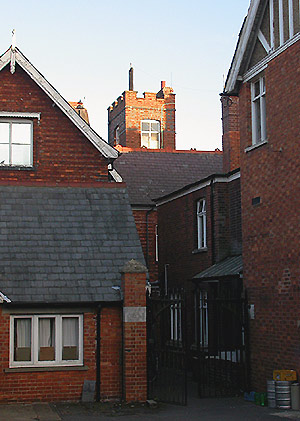
In the latter part of 1938 a radio
listening station, one of a chain of similar
stations spread throughout the country, was
established in a small room under the turreted
water tower situated in the mansion. It was
called Station Ten and, being usually written
with a Roman numeral, it later became known as
Station X.
Its extensive aerial ran first to a
‘cedar’ tree (actually a sequoia!)
some thirty metres from the mansion’s front
door, then to several elm trees, first beside the
lake and finally to another near the present
tennis courts. A return wire to the mansion
completed the antenna loop.
The purpose of the station was to
maintain contact with British embassies. The
radio room was later moved to one of the new
wooden huts, Hut 1. However, the presence of the
large aerial was shortly after considered a
potential threat to security and the radio
station was relocated to Whaddon Hall half a
dozen miles away. This particular enterprise
became known after the war as the Diplomatic
Wirelss Service and was later moved to Easthope
Hall. (See also Part 10)
|
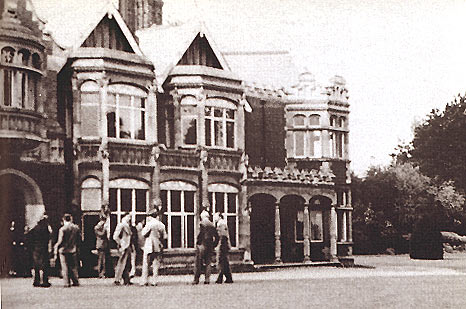
More local interest was aroused
when, in late August 1938, Captain Ridley's
‘shooting party' arrived. Throughout the
month various groups, composed of middle-aged men
and a number of young women, were accommodated in
the local hotels. Each morning they went off to
Bletchley Park and returned to their hotels that
evening. However no-one outside Bletchley Park
would be able identify the members or purpose of
'Captain Ridley's shooting party' until the mid
1970s.
The secret was held for all that
time, not only by the original
‘visitors’ who began working there
that September, but by the thousands of people
who would later join them over the next six
years. Captain Ridley, leader of the so-called
'shooting party', was in fact a naval officer
attached to MI6 who later also organised the
permanent move to Bletchley. (See the next page
for more details of GC&CS)
|
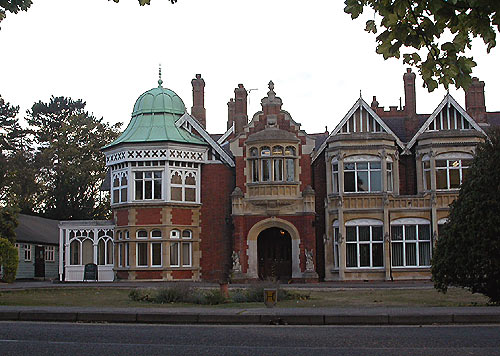
For several months prior to the
outbreak of war members of GC&CS had been
told to prepare to receive orders to move to
another location. A telephone call indicating
that 'Auntie Flo is not so well' indicated that
they were to go immediately to Bletchley Park. On
15 August 1939, the main contingent of code
breakers, again posing as ‘Captain
Ridley’s shooting party, was sent to
Bletchley in order to test communications. The
next call to Bletchley Park was for
real..........
|

|

|
|